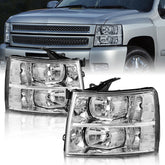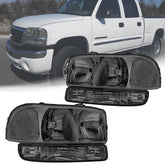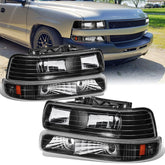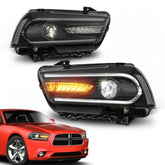How often do headlights need to be replaced?
Do you remember the last time you replaced your headlights? Two years ago, three years ago or you never replaced them. We've had many customers come to us lately and tell us that their headlights aren't as bright as they used to be and it is time to replace them. The answer to this question is yes, when you notice that your headlights are becoming dim, replace them as soon as possible.
Headlights are an essential safety feature of any vehicle, providing visibility during nighttime driving and inclement weather conditions. Be sure to replace them in time to ensure your nighttime driving safety.
In this article, our experts will explain how often headlights need to be replaced, common headlight bulb life spans, and signs that your headlights need to be replaced. It will only take you 3 minutes to become more knowledgeable about your headlights.

How often do headlights need to be replaced?
Your headlights usually consist of two parts, a headlight assembly and a headlight bulb. Headlight assemblies don't have a set lifespan like bulbs, and their replacement depends on the condition of the assembly rather than a specific time frame. There are several signs that your headlights may need to be replaced.
Signs that your headlights need to be replaced
Headlights become dim or not as bright as they used to be
When your headlights become dim, there are usually two things that happen, the first is that you have a problem with the bulb, it is bright at first but after a while, it will slowly go out, at this point, you will have to replace the bulb. The second is a more serious kind of situation, your headlight lenses are dirty or damaged, in this case, you need to replace the entire headlight assembly.
Flickering headlights or burnt-out spots
When you experience that the lights are constantly flickering when you are driving on the road at night, then your headlight bulbs are nearing the end of their life, and it would be a good idea to order a new set of headlight bulbs at this point.

Yellow or cloudy headlights
Over time, the plastic lenses of your headlight assembly can turn yellow or cloudy from exposure to sunlight, UV radiation, and environmental pollutants. This can significantly reduce light output, even if the bulbs are still in good condition. This is when you need to replace the headlight lens or the entire assembly.
Headlight Leaks or Condensation
If you notice moisture or fogging on the inside of the headlight assembly, this is usually a sign that the seal around the assembly has failed. While minor condensation may not require immediate action, persistent moisture can damage bulbs and electrical components, leading to the need for replacement.
Cracked or damaged headlights
If you're often on the highway or rough road driving, the headlight assembly may encounter debris or gravel that can cause it to shatter, in which case you'll have to replace your headlight assembly.
Faded or peeling headlight coating
Some headlight assemblies come with a UV-resistant coating that fades or flakes off over time. Once this layer is damaged, the lenses may deteriorate more quickly, so replacement is a better option than an ongoing fix.

Common headlight bulbs' lifespans
Automotive headlight bulbs should be replaced after an average of 2,000 hours to 3,000 hours of use and usually last about five years. However, different headlight bulb types have different lifespans; here are three common bulb types.
Halogen Bulbs
- Lifespan: Halogen headlights have a lifespan of 450 to 1,000 hours.
- Replacement Frequency: For drivers, this equates to approximately 2 to 4 years.
HID (High-Intensity Discharge) Bulbs
- Life: HID bulbs typically last longer than halogen bulbs, with a typical life of 2,000 to 3,000 hours.
- Replacement Frequency: For drivers, this could mean 5 to 10 years of use.
LED (Light Emitting Diode) Bulbs
- Lifespan: LEDs are known for their long life, typically lasting 15,000 to 30,000 hours.
- Replacement Frequency: Under normal use, LED headlamps can last 10 to 20 years, which means they may not need to be replaced for the life of the vehicle.
In addition to normal life expectancy, the following factors can shorten the life of your headlights:
- Frequent nighttime driving: If you regularly drive at night or in areas that require constant headlight use, you may need to replace your headlights more often than the average driver.
- Harsh conditions: Exposure to extreme temperatures, rough terrain, and frequent switching can shorten the life of your headlights.

How to maintain your headlights?
With an understanding of how long headlights last and how often they should be replaced, effective maintenance will help you reduce the frequency of headlight replacement and extend its life. Here are some tips for maintaining your headlights, compiled by our experts.
Regular Cleaning
Dust, dirt and road debris can build up on the surface of headlight lenses, reducing their brightness. Clean the lenses regularly using a soft cloth, mild soap and water. Once cleaning is complete, polish headlight lenses that are slightly cloudy or dull with headlight polish or a mild abrasive cleaner. Apply the polish with a microfiber cloth in a circular motion, then rinse and air dry.

UV Protection
The plastic lenses in most headlight assemblies degrade over time due to UV exposure, causing yellowing or clouding. Applying a UV protective coating or film helps protect our lenses. In addition, applying a coat of automotive wax to the lens protects the plastic from UV rays and environmental pollutants.
Replacing in pairs
When replacing headlight bulbs, be sure to replace both bulbs at the same time to ensure even illumination. This will also prevent the other bulb from failing soon after the first bulb is replaced.
Use the correct bulb
Make sure you are using the correct type of bulb specified by the vehicle manufacturer. Using the wrong bulb will reduce visibility and may damage the headlight assembly.
Avoid touching the bulb with bare hands
When installing a new bulb, avoid touching the glass with your fingers. The oils on your skin can form hot spots on the bulb and cause premature bulb damage. If you accidentally touch the bulb, clean it with topical alcohol before installation.
Periodically inspect the headlamp assembly
Periodically inspect the headlight assembly for cracks, chips, or other damage. Cracks can allow moisture to enter and affect the bulb or wiring. If the headlight lenses have become blurred or yellowed, use a headlight restoration kit to restore their clarity.
Note: These kits typically include a range of sandpapers, polishes and UV sealers to remove the oxidation that causes blurring.
Upgrading your bulbs
If you're not satisfied with the brightness or performance of your current headlights, consider upgrading to more powerful or modern bulbs, such as LED or HID lights. These bulbs are brighter and last longer than traditional halogen bulbs.
Replacing Outdated Components
If your vehicle's headlights are outdated, consider replacing the entire assembly with modern versions that offer better light output and durability.
Avoid Damage from Debris
Traveling on rough roads or through construction zones can cause your headlight lenses to chip or crack from debris. Try to avoid getting too close to other vehicles, especially on gravel roads, to minimize the risk of damage.
Proper use of headlights
Use headlights in low visibility situations, such as at dusk, dawn or when it's raining. However, avoid using high beams in foggy or snowy conditions as the light reflects particles and reduces visibility.
Conclusion
The lifespan of your headlights depends on a range of factors, including the amount of time your car is driven at night, etc. Our experts recommend that if you use the same bulb for an extended time, it's best to replace it every two years, and the headlight assembly can similarly be serviced every two years to ensure that it's in perfect condition to avoid any problems.
Featured Products
- $116.99
$124.45- $116.99
- Unit price
- / per
- $96.99
$99.99- $96.99
- Unit price
- / per
- $96.99
- $96.99
- Unit price
- / per
- $368.99
$435.77- $368.99
- Unit price
- / per
















